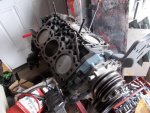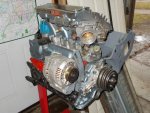So I have an 87 XLT 2WD that is nearing the end of its engine life as far as I can tell. Been nursing it but not sure how long after winter it has. In planning for its overhaul, I've decided to pursue a 3.5l high compression V6 OHV. Using the FRPP engine dimensions, looks like a 4.0l crank, 3.0l Vulcan con-rods and 2.8l .030 flat top pistons will net a 3.320" stroke and 3.670" bore and approximately 10.5-11:1 compression. I picked up the pistons, crank, bearings and one rod to test fit and they look like they should all work together sizewise. Need to clearance the piston skirts a bit for the crank throws, but all of the components mate nicely. Can spin the rod on the journal several times with one finger. I'll see what the block needs after the engine passes on and I yank it out.
Putting all the parts values into DynoSim engine software, with the Camcraft 252/256 cam and free-floated rocker arms, the engine should make 227 hp @5k and 300lb-ft @ 2.5k. Also should make over 200lb-ft from idle up to 5500 rpm and over 170 hp from 3000-7000.
I plan on backing this with an M5OD and BW1354/50 doubler, sent to D44/9" axles running 35/10.5/15s. Will be installing 4.0l clutch and eventually rear discs. Also 2" thick radiator and remote mounted oil filter and cooler.
So my question goes: Has anyone attempted this kind of homebrew stroker and if so, how long did it last? Also, does anyone have actual measurements on the deck height for the 2.8, 2.9 and 4.0l engines? The FRPP info says they have the same deck height, but that doesn't seem right as the 4.0l stroke is so much longer than the 2.9. Way too much to be taken care of with wrist pin height and rod length adjustments.
And before any of you say it, I WANT to stick with the 2.9. Not swapping. Be about the same price, but I won't have to monkey around with harnesses and adapters or worry about the health of the donor motor. And it'll be a true sleeper if the engine still looks like an old beat up 2.9.



















